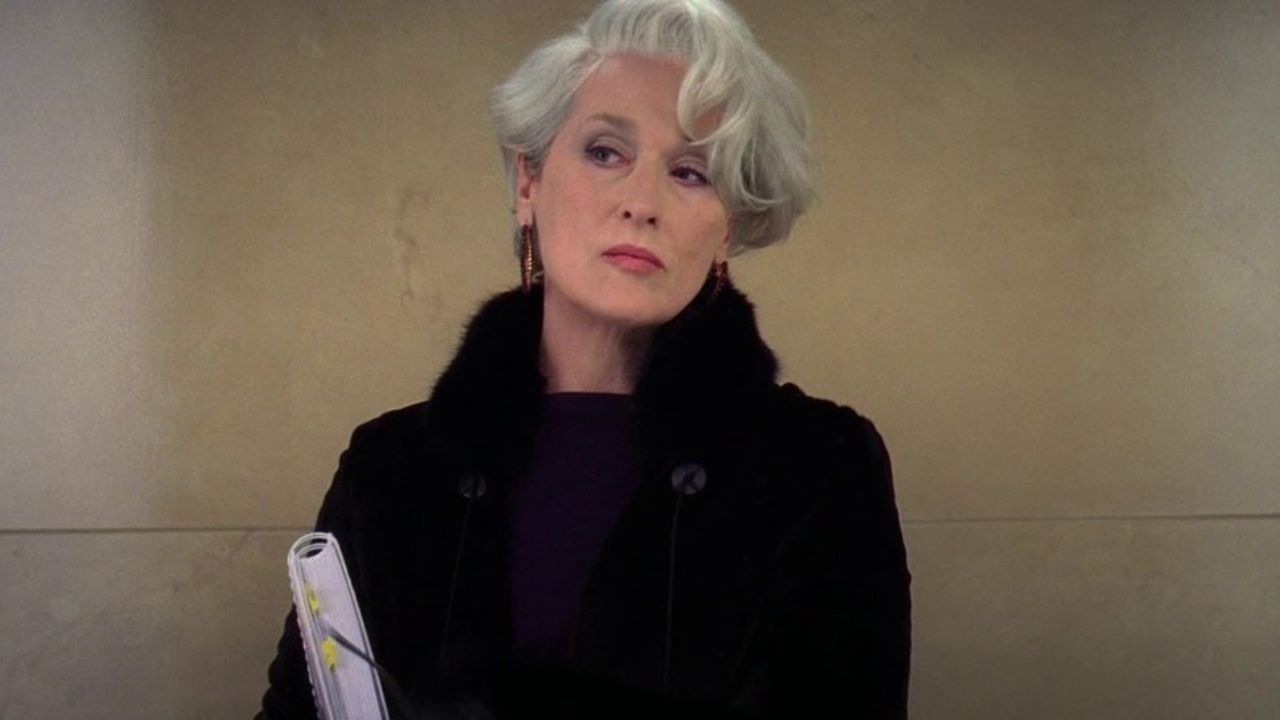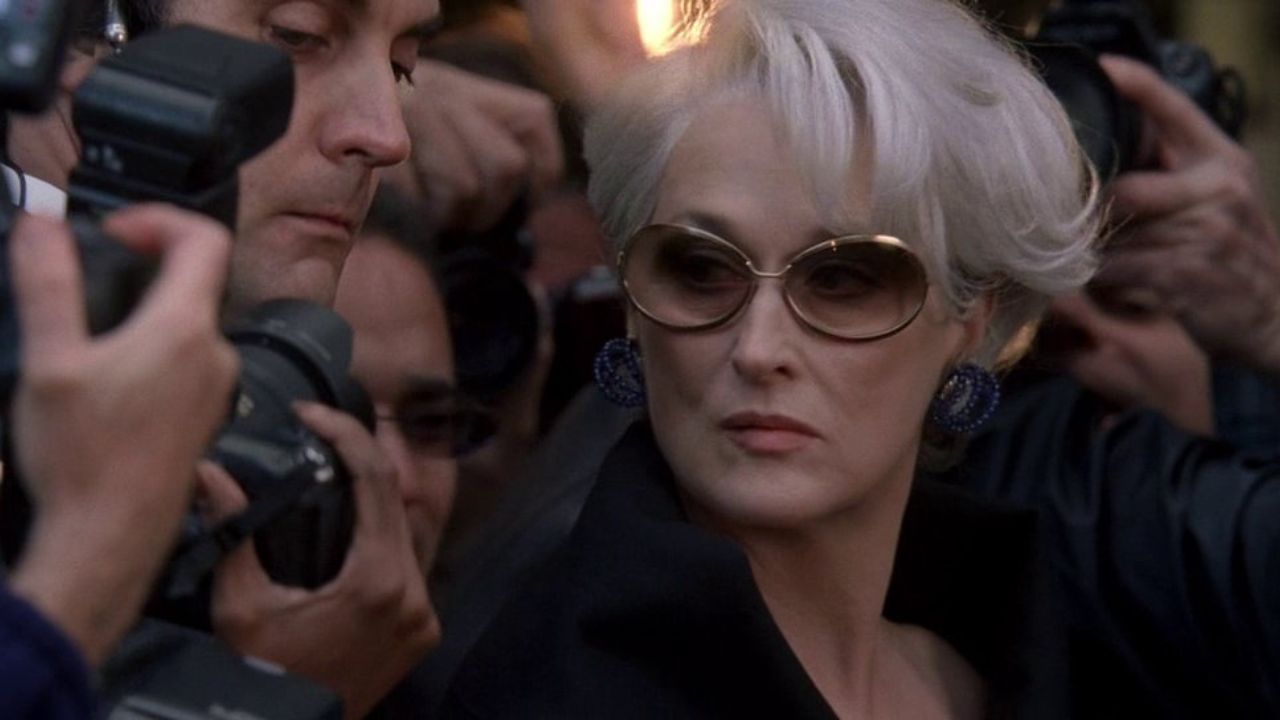This post includes a character analysis of Miranda Priestly, the main antagonist in “The Devil Wears Prada”. Beware of spoilers.
Directed by David Frankel, the 2006 comedy drama stars Meryl Streep as Miranda Priestly. “The Devil Wears Prada” is based on a 2003 novel of the same name written by Lauren Weisberger. Today’s post is solely based on the film, not the novel.
The Devil Wears Prada
In “The Devil Wears Prada”, Miranda Priestly is the ruthless editor-in-chief of a fashion magazine named “Runway”. She hires Andrea “Andy” Sachs, a naive journalism graduate, as her new assistant. However, Andy struggles to cope with Miranda’s demands and fit in with the glamorous world of fashion.
Andy befriends Nigel, the magazine’s art director, who helps her improve her style and attitude. She also meets Christian, a handsome writer who flirts with her. As time passes, Andy starts to enjoy her job and even manages to impress Miranda. But her personal life suffers as Andy neglects her friends and boyfriend.
Miranda decides to take Andy to Paris Fashion Week instead of Emily, her senior assistant. Although Andy feels guilty, she ends up accepting the opportunity. In Paris, she learns that Miranda’s job is in danger.
To Andy’s surprise, Miranda betrays Nigel, who was supposed to get a promotion, to save herself. Jacqueline, Miranda’s rival, got it instead. Without her main competition around, Miranda gets to keep her job as editor-in-chief of Runway.
Meanwhile, Andy is torn between loyalty and morality. She doesn’t agree with Miranda’s actions. Also, Andy realizes that Miranda’s success comes at a high cost and that she doesn’t want to become like her. As a result, Andy quits her job.
Back in New York, Andy reconciles with her friends and boyfriend. She also gets an interview with a newspaper, thanks to Miranda’s recommendation. Then, Andy sees Miranda on the street and smiles at her, but Miranda ignores her and walks away.
Miranda Priestly Character Analysis in “The Devil Wears Prada”
“The Devil Wears Prada” presents Miranda Priestly as the formidable editor-in-chief of Runway magazine, the epitome of high fashion. Her striking silver hair, sharp gaze, and impeccable style command attention. In addition, Miranda carries an air of authority, making her presence felt the moment she steps into a room.
In terms of personality, Miranda Priestly is unapologetic, demanding and a perfectionist. She is someone who emanates power and control. Miranda’s icy demeanour and cutting remarks keep everyone on their toes. Nonetheless, beneath her tough exterior, there’s a hint of vulnerability, adding depth to her persona.

Miranda Priestly and Leadership Style
The leadership style of Miranda Priestly is based on power and control. She often uses fear and intimidation to motivate her followers. Most of the time, Miranda makes all the decisions and rarely consults others or delegates. In addition, Priestly seldom gives praise or rewards to her employees.
Overall, the editor-in-chief of Runway magazine is very demanding and authoritative. Miranda expects her subordinates to be loyal, obedient and efficient. Having said that, she does not tolerate mistakes or excuses. In addition, Priestly will not hesitate to criticize and humiliate in public those who do not meet her standards.
What does “Fashion” mean to Miranda Priestly?
As the influential editor-in-chief of a prestigious fashion magazine, “fashion” is not only Miranda Priestly’s work but also her passion and identity. The woman’s impeccable fashion sense reflects her high status and taste. Sometimes, Priestly will even use her knowledge of fashion as a tool to impress or intimidate others.
In many ways, Miranda’s journey in the fashion industry is both a gift and a curse. On the one hand, she was able to achieve success and fame. But on the other hand, Priestly has met tremendous challenges in her personal life. As a matter of fact, Miranda has a rather troubled love life. She has divorced twice and has a strained relationship with her children.
The personal sacrifices that Miranda has made don’t mean much to others. First, she has earned herself an infamous reputation. Second, her job is constantly on the line as younger and more ambitious competitors come along. Nevertheless, Priestly relies on and trusts her instincts in fashion, which is the only thing that gives her a sense of control in life.
Miranda Priestly and Influence in Pop Culture
The iconic editor-in-chief of a high fashion magazine in “The Devil Wears Prada”, has had a significant influence on pop culture. It has somehow impacted how people view the fashion industry and female leaders.
In many ways, Miranda Priestly represents a shift from traditional gender roles, challenging the male-dominated business world. Her character breaks many stereotypes and expectations of women in power.
Priestly is not your typical female boss who is nice, supportive, or maternal. She is cold, demanding, and intimidating. Also, Miranda does not care about pleasing others or being liked. She is rather focused on being successful and respected.
The editor-in-chief of “Runway” shows that women can be strong, ambitious, and assertive without apologizing for it. Despite being a controversial and complex character, Miranda Priestly continues to resonate with audiences for her uncompromising pursuit of excellence and power.
Is Miranda Priestly the villain in “The Devil Wears Prada”?
Despite her bad reputation, Miranda Priestly is not the real “villain” in “The Devil Wears Prada”. Miranda Priestly is not good or bad, she is merely fulfilling her role as a leader. The editor-in-chief of Runway holds herself to the same high standards she expects from others.
Miranda indeed pulled a cunning maneuver towards the end: sacrificing her loyal confidant, Nigel, to secure her position. However, many in her position would have done the same. By enticing Jacqueline to another company, she brilliantly eliminated a potential threat to her reign at Runway.
Miranda Priestly’s perfectionism is often misconstrued as tyranny, especially when contrasted with Andrea’s relatability. Now, if Miranda were a man, would she still be labeled as harsh? Likely not. Many would describe Priestly as “icy” and unapproachable. Although it’s true that she rarely smiles and lacks empathy, these traits do not diminish her professional capabilities.
The editor-in-chief’s job does not require someone to be nice, it demands results. Miranda’s relationship with Andrea is a testament to this. Priestly’s requests may seem outrageous to those outside her sphere, but she employs individuals to fulfill her demands, not to question her. It’s not Miranda’s responsibility to determine if her assistants can meet her expectations, it’s theirs to figure out how.
Unlike Andrea Sachs, Miranda embraces her identity and desires without hesitation. Andrea had the option to decline the Paris trip but chose not to. What was at stake? Her job? By accepting Miranda’s offer, Andrea prioritized her career over Emily’s feelings. Does this make Andrea morally superior to Miranda? Not really.

In conclusion, Miranda Priestly is not the “bad guy” in “The Devil Wears Prada”. As a matter of fact, she harboured no resentment towards Andrea for leaving Runway. If she did, the woman wouldn’t have recommended Andrea for another job. Although Miranda was “disappointed” in Andrea, she also knows that individuals like her don’t belong at Runway.
Final Thoughts
Miranda Priestly’s influence on pop culture is profound. She embodies a powerful, assertive woman in a high-ranking position, challenging traditional gender norms and inspiring many to embrace their inner strength.
While it might be an unpopular opinion, Miranda Priestly’s reputation as a villain may be undeserved. As an individual navigating the demanding landscape of her profession, Miranda’s high expectations are merely a reflection of her commitment to her role.
This realization highlights a broader societal issue: the double standards that unfairly judge women in positions of power. If Miranda were a man, the criticism she faces for her actions and demeanour would likely be significantly less.
After watching “The Devil Wears Prada,” it becomes apparent that the corporate sphere could benefit from more leaders like Miranda. The key takeaway? More people need to worry less about what others think of them, speak up when it’s necessary, and be more assertive.
Lastly, there should be no obligation to apologize for fulfilling one’s professional duties. Having said that, it is unjust to label Miranda Priestly as an “evil woman” exploiting her subordinates. Instead, she should be recognized as a competent leader who happens to be a woman.


